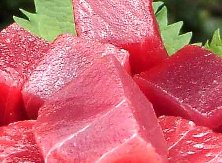Bluefin Tuna (maguro) And The Different Grading System
What Is Toro Sushi And Why Does Fat Matter In Maguro ?

The Story of Maguro, Toro, And Why Bluefin Was Not Always on The Menu
While currently suffering from over-fishing, tuna was, until the 1970’sinterestingly, thrown away. Now, its fatty belly meat, known as ‘toro sushi’ is one of the more expensive items on the menu, prized for its taste, texture, and scarcity.
Due to high demand, which is not surprising as it is such a versatile and tasty fish, the population of bluefin tuna is in serious decline, unfortunately, leading to continued efforts to regulate the catch.
Originally a a sport fish colloquially known as “horse mackerel” it was sold to companies for cat food or sometimes, thrown away. The name “horse mackerel” is now used for the fish called “Aji” (or jack mackerel) because, for marketing purposes, seafood purveyors didn’t want the strong flavor of mackerel associated with the much less oily and fishy tasting bluefin tuna.
Tuna has come a long way from being a fish the samurai considered unclean and would not eat, to one of the most popular fish eaten in Japan, and the world around, particularly the coveted fatty parts of the fish served as toro sushi.
The Different Ways To Serve Maguro As Sushi
Tuna served in restaurants is generally one of two different species, the bluefin tuna (Thunnus thynnus), traditionally known as “maguro,” which is usually fairly lean, and the yellowfin tuna (Thunnus albacares), known as “ahi” (ah-hee), which is a fattier species, and is slowly becoming more common due to over-fishing of the bluefin tuna.
Yellowfin tuna may also be labeled “maguro” as there are no legal standards in most countries, but if you see maguro on the menu it will hopefully be bluefin tuna. Tuna sushi is further broken up into grades, based on the fat content.
Akami And Toto – The Different Cuts Of Tuna By Texture And Part Of The Fish
Just as with animals such as a a cow, which offers many different cuts of meat to create a diverse range of steaks and other offerings, the meat of the tuna fish can be incredibly different depending on where on the fish it is from. Therefore, tuna is offered as different cuts, based on location, which will affect texture and quality. Typically you will find:
- Akami (ah-kah-me) is the leaner meat from the sides of the fish. If you ask for ‘maguro’ at a restaurant, or order any kind of tuna roll or sushi without requesting ‘toro,’ you will get this cut.
- Toro (toh-roh) is the term for the fattier part of the tuna,and is the term used for the belly portion of the fish. It is well-known for its rich flavor and buttery texture due to the high fat content. The marbled texture of the fat may even surprise some people as it almost resembles a high quality beef, like Kobe beef, a truly magical taste experience. Toro is further broken up into two distinct sub-types, and they are more expensive due to their relative scarcity as a proportion of the entire fish as well as the degree of marbling in the meat. The two types of toro are:
- Chutoro (choo-toh-roh), which is sometimes labeled chu-toro or Chūtoro (as “chuu” means “middle” in Japanese), is the belly area of the tuna along the side of the fish between the akami and the otoro. It is often preferred because it is fatty but not as fatty as otoro.
- Otoro (oh-toh-roh), which is sometimes labeled O-toro, is the fattiest portion of the tuna, found on the very underside of the fish’s belly. This cut is fatty almost to the point of falling apart and can literally melt in your mouth, a delicious and practically unique experience.
The Sustainability of Maguro For Sushi
Today, approximately 80% of the world’s bluefin tuna catch is used for sushi, and the species is actually close to being threatened, and due to this, they are becoming more expensive. Toro (and especially otoro) is generally the most expensive item in the menu by weight, and in fact the fish themselves can command record prices. On January 5th, 2001 in Tokyo, a sushi grade bluefin tuna was sold for an astounding $173,600 for a 444 pound fish (which equates to $391/lb). I have personally seen people waiting on the docks ready to buy the catch of those who have spent a day deep sea fishing for tuna. This diverse fish is now one of the most popular items on the sushi menu, but hopefully its culinary success will not be its downfall.
